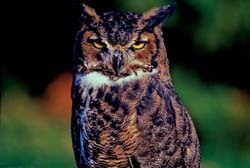BIRD OF THE MONTH: OWLS
Owls are fascinating birds. They are mysterious, captivating and unique in many ways.
For instance, the eyes of owls are located on the front of the head instead of on the side. This not only gives them a very human appearance but also enables them to match our level of depth perception that is created by the overlapping vision from each eye.
The ears of most owls are special, too. They are located asymmetrically on their head with the right ear higher than the left ear. Each ear hears the same sound with a slight difference, thus creating a form of audible "depth perception" which can be used to track the location and movements of their prey.
The feathers of owls are especially soft and muffle wind noise. Many owls also have comb-like fringes on the leading edge of their wings to help channel air over the wing, thereby reducing noise. These adaptations for silent flight allow the owl to make a soundless approach towards its prey.Many owls can turn their heads over 270 degrees allowing them to look almost directly behind themselves. This adaptation has developed to compensate for the fact that their eyes are fixed into a boney socket in the skull and are virtually unable to move.
Let's take a look at some common owls and learn some fun and cool facts about each of them.
Great Horned Owl
This owl can be found virtually anywhere in North America. Its habitat ranges from forest, field, tundra and desert and includes highly developed suburban areas as well.
When fully spread out, the talon of a Great Horned Owl can span up to eight inches wide. When clenched, it requires a force of 28 pounds to open. The owl uses the grip of its talons to sever the spines of large prey.
Large prey for this owl can include ospreys, peregrine falcons, prairie falcons, other owls, skunks and porcupines. They will also eat rodents, frogs and scorpions.
The male Great Horned Owl has a lower pitch and slower call than the female.
The Great Horned Owl nests earlier than any other bird of prey in North America.
A southern legend says that if you hear a Great Horned Owl call coming from your left side it is forecasting bad luck for you.
The Great Horned Owl is probably the longest-lived owl in North America, the oldest known being 28 years old.
Snowy Owl
Males are barred with dark brown when young then become whiter as they age. Females keep some dark markings throughout their lives. The whitest mature owls are always males.
These owls are diurnal. They will hunt at all hours during the continuous daylights of an Arctic summer.
An adult Snowy Owl may eat more than 1600 lemmings in a single year.
Snowy Owls are the heaviest of all owls weighing in at about 4 pounds due to thick insulating feathers.
The oldest Snowy Owl was 23 years, 10 months old.
Spotted Owl
Flying squirrels and wood rats are high priority prey for these owls. They will also eat bats and other owls.
Spotted Owls will cache prey in moss-covered limbs, under moss-covered rocks, in broken stumps and under logs. After stashing its treasure, the owl will step back and stare at its hiding place as if memorizing its location before walking or flying away.
The oldest Spotted Owl recorded is 21 years old.
Western Screech Owl
The Western Screech Owl doesn't screech. It makes an accelerated series of hollow toots.
This owl can take prey bigger than its own body such as a cottontail rabbit.
The Western Screech Owl will sometimes perch at the entrance to its roost hole during the day but will press its head and body against the tree to blend in.
The oldest Western Screech Owl in the wild is recorded at 13 years. In captivity, 19 years old.
Barred Owl
Pleistocene fossils, 11,000 years old, of this owl have been found in Florida, Tennessee and Ontario.
Barred Owls do not migrate, in fact, they hardly go anywhere. In a study of 158 Barred Owls, none of them moved beyond a radius of 6 miles over a year's time.
Young Barred Owls can climb trees by using their bills and talons to grasp the bark, flapping their wings and "walking" up the trunk.
The oldest Barred Owl lived to be 24 years, 1 month old.
Barn Owl
Barn Owls swallow their prey whole - skin, bones and all - then twice a day cough up pellets instead of passing all the material through its digestive system.
This owl's ability to locate prey by sound alone is the best of any animal ever tested.
The oldest Barn Owl lived to be 15 years, 5 months old.

